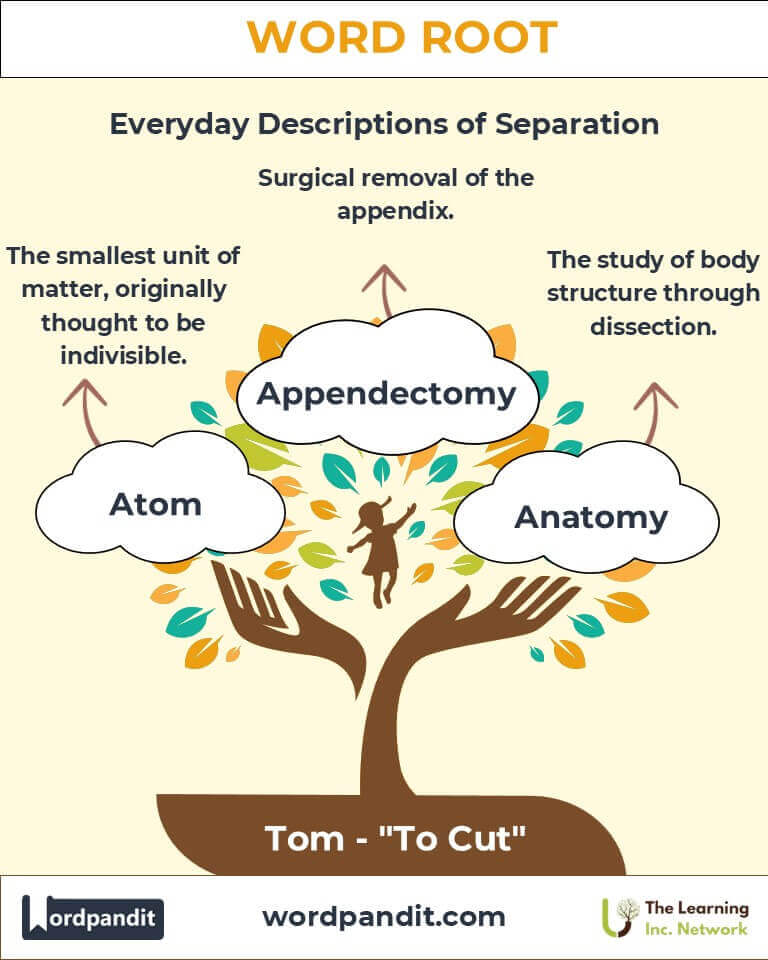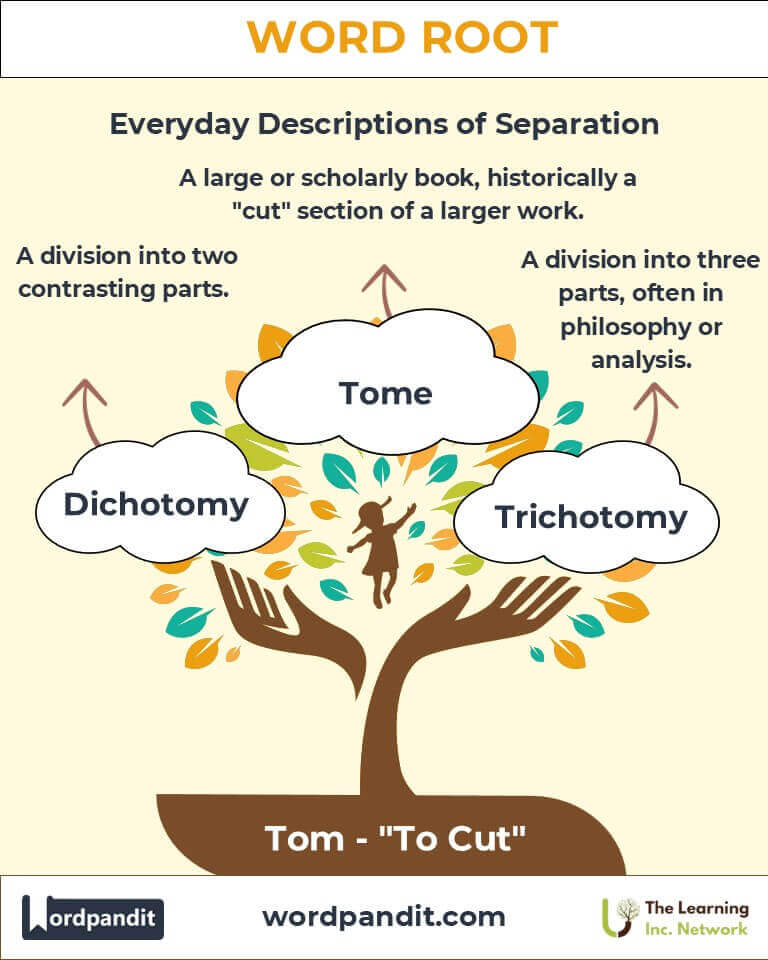Tom: The Root of Precision and Division in Language and Science
Byline: Discover how the root "Tom," derived from the Greek word "temnein" meaning "to cut," shapes words that signify division, precision, and surgical accuracy. Explore its role in science, medicine, and everyday language.

Table of Contents
- Introduction: The Essence of "Tom"
- Etymology and Historical Journey
- Mnemonic: Unlocking the Power of "Tom"
- Common "Tom"-Related Terms
- "Tom" Through Time
- "Tom" in Specialized Fields
- Illustrative Story: "Tom" in Action
- Cultural Significance of the "Tom" Root
- The "Tom" Family Tree
- FAQs About the "Tom" Word Root
- Test Your Knowledge: "Tom" Word Root Quiz
- Conclusion: The Lasting Precision of "Tom"
1. Introduction: The Essence of "Tom"
Imagine a world without precision—no surgeries to heal us, no fine instruments for science, and no exact words to express ourselves. The root "Tom" (pronounced "tahm") empowers language with the concept of cutting, dividing, or dissecting. Derived from the Greek root temnein, meaning "to cut," it features prominently in words like "atom" (indivisible particle) and "appendectomy" (surgical removal of the appendix). Its significance stretches across fields like medicine, science, and linguistics.

2. Etymology and Historical Journey
The root "Tom" traces back to the ancient Greek word temnein. In Greek, it described the act of cutting or dividing, often used in both literal and metaphorical contexts. As languages evolved, "Tom" became a versatile linguistic tool, finding its way into Latin ("tome" for a large book or section) and eventually into English. With the scientific revolutions of the 17th and 18th centuries, terms like "atom" and "anatomy" emerged, cementing "Tom" in the lexicon of discovery and precision.
3. Mnemonic: Unlocking the Power of "Tom"
Picture a scalpel cutting through a sheet of paper with surgical precision. This image encapsulates the essence of "Tom"—to cut or divide cleanly.
Mnemonic Device: "Tom slices through complexity, from atoms to appendices."
4. Common "Tom"-Related Terms
- Atom (A-tahm):
- Definition: The smallest unit of matter, originally thought to be indivisible.
- Example: "Scientists study atoms to understand the building blocks of the universe."
- Appendectomy (Ap-pen-dek-tuh-mee):
- Definition: Surgical removal of the appendix.
- Example: "After a sudden pain, the patient underwent an appendectomy."
- Dichotomy (Die-kot-uh-mee):
- Definition: Division into two contrasting parts.
- Example: "The book explores the dichotomy between good and evil."
- Anatomy (Uh-nat-uh-mee):
- Definition: The study of the structure of living things, often through dissection.
- Example: "Anatomy classes include dissections to study body systems."
- Tome (Tohm):
- Definition: A large or scholarly book.
- Example: "The professor’s office was filled with ancient tomes on philosophy."
5. "Tom" Through Time
- Atom (Ancient to Modern):
- Historical Context: The term "atomos" was introduced by Greek philosopher Democritus to describe the indivisible building blocks of matter.
- Modern Use: Quantum physics revealed that atoms can, in fact, be divided into subatomic particles.
- Anatomy (Renaissance):
- Historical Context: During the Renaissance, advances in anatomy transformed medicine and art, exemplified by Leonardo da Vinci's detailed dissections.
- Modern Use: Anatomy remains a cornerstone of medical education.
6. "Tom" in Specialized Fields
- Medicine:
- Appendectomy: A lifesaving surgical procedure to remove the appendix.
Importance: Reduces complications from appendicitis.
- Appendectomy: A lifesaving surgical procedure to remove the appendix.
- Physics:
- Atom: The foundation of matter and central to chemistry and quantum mechanics.
Significance: Understanding atoms has led to technological breakthroughs like nuclear energy.
- Atom: The foundation of matter and central to chemistry and quantum mechanics.
- Philosophy:
- Dichotomy: A critical concept in ethics and logic.
Example: Philosophers debate dichotomies like free will vs. determinism.
- Dichotomy: A critical concept in ethics and logic.
7. Illustrative Story: "Tom" in Action
Dr. Elena Martin, a renowned surgeon, faced a challenge: a patient with a life-threatening appendix rupture. Drawing on her knowledge of anatomy, she performed a delicate appendectomy, saving the patient’s life. Meanwhile, her physicist husband explained the concept of atomic fission to their daughter, connecting their shared passion for precision and division. Together, they illustrated how "Tom" shapes both life-saving interventions and the understanding of the universe.
8. Cultural Significance of the "Tom" Root
The root "Tom" symbolizes humanity’s quest for understanding and mastery. From the precise cuts of a surgeon to the metaphorical divisions in philosophy, it reflects our need to analyze, categorize, and comprehend. In literature, "tomes" preserve knowledge, while in science, "atoms" reveal the universe's secrets.

9. The "Tom" Family Tree
- Sect (Latin: "to cut"):
- Section: A part cut or divided from a whole.
Example: "The report’s most crucial section analyzed economic trends." - Dissect: To cut apart for analysis.
Example: "The students dissected frogs to study anatomy."
- Section: A part cut or divided from a whole.
- Cis (Latin: "to cut"):
- Incision: A surgical cut.
Example: "The surgeon made a precise incision to remove the tumor." - Decision: A metaphorical cutting of choices.
Example: "Making a decision often requires careful thought."
- Incision: A surgical cut.
- Scind (Latin: "to split"):
- Rescind: To cut off or revoke.
Example: "The company decided to rescind the policy after public outcry."
- Rescind: To cut off or revoke.

10. FAQs About " Tom "
Q: What does the root "Tom" mean, and where does it come from?
A: The root "Tom" means "to cut" or "to divide" and originates from the Greek word temnein. This root is often used in terms that describe physical or metaphorical division, such as "atom" (indivisible particle) or "appendectomy" (a surgical procedure involving cutting).
Q: How does "Tom" relate to the word "atom"?
A: The word "atom" comes from the Greek atomos, meaning "indivisible." Philosophers like Democritus believed atoms were the smallest, uncuttable units of matter. Today, while atoms are no longer considered indivisible, the term retains its connection to the concept of division in science.
Q: Why is "Tom" important in anatomy?
A: Anatomy, derived from the Greek anatome ("cutting up"), is the study of the structure of living organisms, often through dissection. The root "Tom" highlights the process of cutting and examining tissues to understand how bodies function.
Q: What is the difference between a "tome" and a "dichotomy"?
A: A "tome" refers to a large or scholarly book, historically considered as a "cut" or "section" of a larger work. A "dichotomy," on the other hand, represents a division into two contrasting parts, often used metaphorically in discussions about ideas or categories.
Q: How does "Tom" feature in modern medicine?
A: Terms like "appendectomy" (removal of the appendix) or "tonsillectomy" (removal of tonsils) use "Tom" to signify cutting as part of surgical procedures. This underscores its role in life-saving and diagnostic interventions.
11. Test Your Knowledge: " Tom " Mastery Quiz
1. What does "Tom" mean?
2. Which word describes the smallest unit of matter?
3. What is the study of body structures through dissection?
4. Which term describes a division into two contrasting parts?
5. What is an appendectomy?
12. Conclusion: The Lasting Precision of "Tom"
The root "Tom" exemplifies humanity’s drive for precision and understanding. From dissecting ideas to performing intricate surgeries, it underscores the importance of division in both thought and practice. As language and science evolve, "Tom" continues to cut through complexity, shaping the tools and concepts that define our world.












